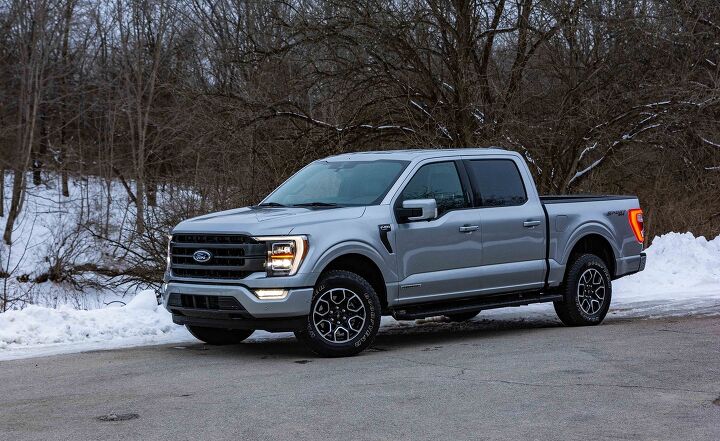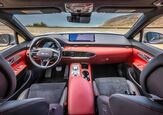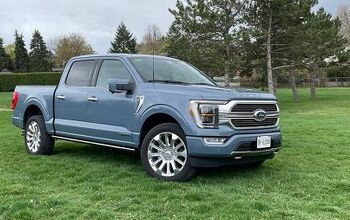2021 Ford F-150 PowerBoost Hybrid Review: This Isn't Your Father's Hybrid

FAST FACTS
| Engine: | 3.5-liter V6 turbo w/ hybrid electric motor |
| Output: | 430 hp, 570 lb-ft |
| Transmission: | 10AT, 4WD |
| US fuel economy (MPG): | 24/24/24 |
| CAN fuel economy (L/100KM): | 9.8/9.7/9.8 |
| Starting Price (USD): | $52,675 (inc. dest.) |
| As Tested (USD): | $68,095 (inc. dest.) |
| Starting Price (CAD): | $63,895 (inc. dest.) |
| As Tested (CAD): | $76,665 (inc. dest.) |
For over two decades, the popular image of a hybrid has been that of a compact camped in the passing lane driving slower than the speed limit.
Indeed, while keeping speeds down does stretch each gallon of refined dead dinosaur as far as possible, it’s given hybrids a bad name among those not specifically focused on efficiency. The technology behind those trendsetting hybrids, however, has trickled down into nearly every market segment—from mild hybrids that simply have a start/stop function to save a few thimbles of fuel while stopped at a traffic light, to supercars taking advantage of the near-instant torque of an electric motor to launch off the line.
Get a Quote on a New Ford F-150 HybridPerhaps that’s why Ford has chosen to not outwardly label its latest 2021 Ford F-150 Powerboost as a hybrid—though that’s exactly what this truck is. Rather than a focus on supreme fuel economy, this truck is meant for what we think of a truck for: work.
The F-150 PowerBoost has been in the news lately, specifically due to the available 7.2-kilowatt generator that can be powered by the truck’s gas engine. A flip of a switch in the cab gives 120 or 240 volts at the back of the bed; perfect for powering job site tools, a small camper, or even bringing heat to a home that’s lost power due to a freak winter storm.
This feature alone is enough for me to recommend the PowerBoost. Being able to power some tools at a job site is a game-changer. I can picture small contractors who do remodeling jobs not worrying about plugging into a homeowner’s outlets for the variety of tools needed for a project. That’s important, especially when the power’s been turned off to the house. Likewise, taking a camper off-grid for a few days will extend your time in the wilderness to the capacity of the black and grey tanks on the trailer, rather than the limited power in a trailer battery.
Another key feature for the jobsite is the optional Interior Work Surface—for $165 US ($200 CDN) the shift lever will fold down with a button push into the console, allowing a long flat surface between the front seats perfect for a laptop (which can be charged from a 120v outlet in the dash), paperwork (gotta invoice that remodeling customer), and likely greasy bags of fast food.
Obviously, the shift lever only folds while the transmission is in park—and is smart enough to not fold down if a cellphone or keys have been placed in the compartment. Yes, I found this by accident.
Higher trims (King Ranch and above) allow another option for those who spend entirely too much time in their trucks: a pair of Max Recline seats up front that will lay very nearly flat for sleeping. Add a camping toilet in the bed and one could probably live in the F-150. Seat comfort is quite good, and the general look of the interior is improved over years past. I still prefer the materials used on the Ram 1500 ever so slightly, but unless you’re looking for old-school Lincoln levels of luxury from your pickup truck you’ll be happy with any of the mid-range to upper-trim F-150s.
Exterior styling is best referred to as evolutionary. I live about a mile from the nearest Ford dealer, so I’m driving by quite frequently (you bet I’ll be making more frequent drives once the Bronco hits the floor) and I’ve been struggling to pick out the 2021 F-150 from the outgoing model. It’s still a handsome, if quite slab-sided beast that will soon be ubiquitous. I just would like a bit more visual interest like the transition between the 1996 and 1997 model years.
Driving the F-150 PowerBoost is, nearly all of the time, seamless. It nearly always feels just like any other truck. There are, however, very minor but perceptible moments where you do realize that you’re driving a hybrid. It’s most noticeable at a long stoplight, where the engine needs to kick in as the battery depletes because someone at the county highway department programmed an extra long red light for some inexplicable reason. The transition from electric to gas comes, occasionally, with a noticeable shake and shimmy to the cab. Not always by any means—and it’s not disconcerting—but it’s something to be aware of.
Regarding the fuel economy, the EPA rates this PowerBoost Hybrid 4×4 F-150 at 24 city, 24 highway, and (surprise) 24 mpg combined. Natural Resources Canada gives figures of 9.8 city, 9.7 highway, and 9.8 L/100 km. Compare that to the figures quoted for the non-hybrid 3.5-liter turbo V6, also with 4×4: 18 city, 24 highway, and 20mpg combined (13.5/10.2/12.0 L/100 km for Canada). I’ll revert to my local freedom units now: that’s a 4 mpg combined difference between the hybrid and standard versions of this truck, which could prove significant over the miles.
I’m not completely convinced that the 24 mpg combined would be consistently achievable: in my week of driving, the calculated consumption shown on the instrument panel stayed right at 18.0 mpg. To be fair, I couldn’t get enough driving done to run through a full tank, and the entire week was spent in sub-freezing temperatures, which is not conducive to getting significant range from hybrid batteries. If Ford wants to give me a month-long loan so I can do a few proper tankfuls, I’d be happy to report my more conclusive economy findings.
In speaking with Ford communications manager Mike Levine, he tells me that “the hybrid powertrain is a productivity booster with new capability like the mobile generator.” The typical fuel economy boost expected from a hybrid is more of a bonus than the focus of the hybrid powertrain—which is why you don’t see “HYBRID” stickers or badges plastered all over the truck. Rather, an understated PowerBoost badge adorns each front door.
There’s no question that modern trucks can get incredibly expensive. Thankfully, the hybrid powertrain is available across all trim levels of the SuperCrew F-150—even the base XL trim. An XL 2WD F-150 SuperCrew PowerBoost—with only the upgrade from the 2.4 kW generator to the 7.2 kW unit better suited to running a bunch of tools—works out to $44,405 US ($45,679 CAN) delivered. Of course, you can go crazy with options, but for a basic work truck this is brilliant.
This is a very different kind of hybrid—one that makes the vehicle much more usable beyond the commute. Instead of camping in the left lane, you’ll likely be seeing the 2021 Ford F-150 PowerBoost hooked to a camper.
LOVE IT
- Built-in generator not at all a gimmick
- Great handling and driving manners
- All-day driving comfort
LEAVE IT
- Fuel economy not stellar for a hybrid
- Ticking the boxes makes it quite pricey
- Doesn't shout HYBRID to neighbors clucking tongues at you for driving a big truck

A lifelong Ohioan, Chris grew up around classic rusty sports cars from Japan and England. He's been covering the automotive industry for nearly 10 years, and is a member of the Midwest Automotive Media Association (MAMA). A family man, Chris drives a Chrysler minivan, and uses his rusty old Miata as a shelf, until the day it is uncovered as a priceless barn find.
More by Chris Tonn









































Comments
Join the conversation